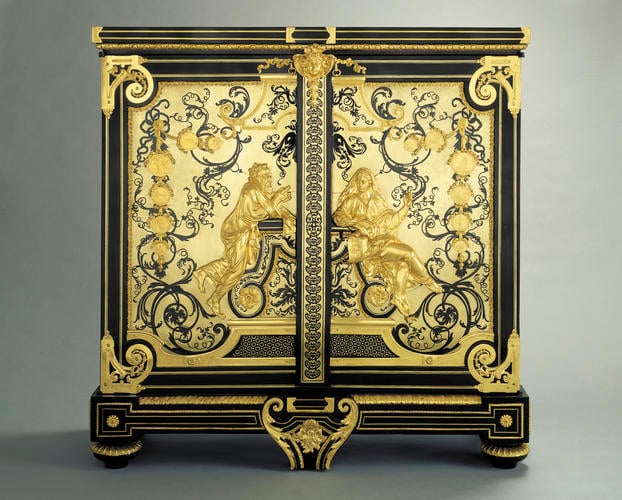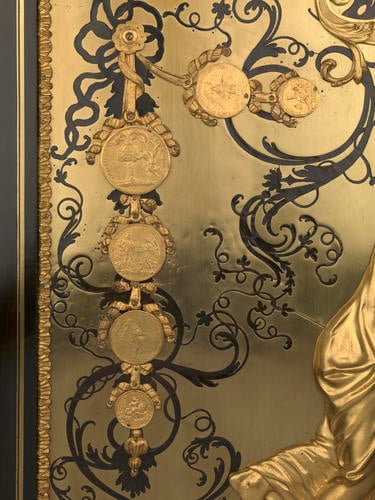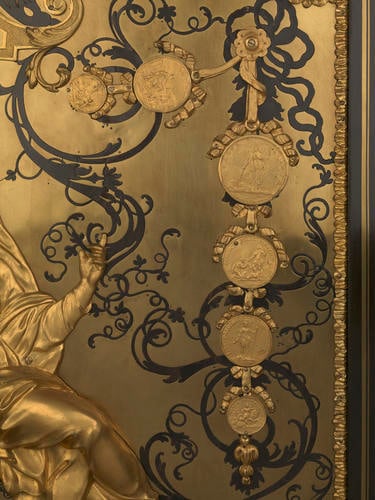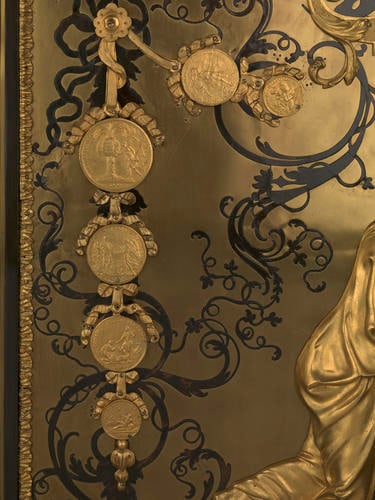-
1 of 253523 objects
Two medal cabinets c.1735-40
Oak, tortoiseshell, brass | 126.0 x 126.8 x 45.0 cm (whole object) | RCIN 35486

Attributed to André-Charles Boulle (1642-1732)
35486.tif c.1735-40

Attributed to André-Charles Boulle (1642-1732)
35486.1 detail 1.tif c.1735-40

Attributed to André-Charles Boulle (1642-1732)
35486.1 detail 2.tif c.1735-40

Attributed to André-Charles Boulle (1642-1732)
35486.2 detail 1.tif c.1735-40

Attributed to André-Charles Boulle (1642-1732)
35486.2 detail 2.tif c.1735-40





-
Pair of upright rectangular ebony and boullework cabinets; each with two doors mounted in gilt bronze with a kneeling, bearded, man (Socrates) and seated woman (Aspasia), who holds architectural designs in her right hand and points with her left; surrounded by garlands of medals. White marble tops.
Twenty-five of these cabinets, dating from three distinct periods in the eighteenth century, have been identified. The first group, made under the direction of André-Charles Boulle himself, probably dates from 1705-15; the second, to which this pair belongs, are repetitions from Boulle's workshop of the 1720s and 1730s. A third group dates from the period after 1760 when a number of new versions were made and several existing examples, from the first or second periods, were restored.
Although the earliest of these cabinets were certainly intended for medals, probably for use by Louis XIV as diplomatic gifts (Présents du Roi), by the 1730s they were as likely to have been used - in spite of their very specific decoration - simply as cabinets for books or other articles. In the case of these cabinets and several others of this second group, there is no physical evidence that they ever contained medal shelves, though they retain the central foot which was originally designed to support the weight of medals.
The figures of Socrates and Aspasia (the mistress of Pericles), constant features of the decoration of these cabinets, derive either from Michel Corneille's painting of 1673 on the ceiling of the Salon des Nobles at Versailles or perhaps from a drawing by Corneille of the same subject in Boulle's possession. Both figures of Aspasia on the cabinets are signed on the reverse by an unidentified bronze-maker, C(?) Richar[d]. The casts of medals on the doors are dated between 1643 and 1697, record the principal events of Louis XIV's reign and are often (as in the present case) of surprisingly low quality.
George IV shared to the full the contemporary passion for Boulle furniture and acquired many splendid examples. These cabinets may have been purchased from the dealer Robert Fogg in 1813. They were at Carlton House in the Blue Velvet Closet in 1818 and in the library by 1826. Despatched in 1828 to Morel & Seddon for restoration and placed in the King's Writing Room at Windsor Castle, they were subsequently transferred to the Grand Corridor.
One stamped DELORME (for J.L.F. Delorme, maître 1763, as restorer); two bronzes stamped FAIT par C [?] Richar.
Catalogue entry from Royal Treasures, A Golden Jubilee Celebration, London 2002Provenance
Possibly Robert Fogg; from whom acquired by George IV, 2nd February 1813.
Placed in the Blue Velvet Closet, Carlton House, where they appear in a watercolour of c.1818. Sent from the Library at Carlton House to Morel & Seddon on 10 January 1828 for refurbishment as part of the group of furniture and furnishings supplied between 1827 and 1829 to King George IV by the partnership of Morel and Seddon for His Majesty’s Writing Room Windsor Castle. Delivered to Windsor 2 July 1828. -
Creator(s)
(restorer)(restorer)(nationality)Acquirer(s)
-
Medium and techniques
Oak, tortoiseshell, brass
Measurements
126.0 x 126.8 x 45.0 cm (whole object)
Category
Object type(s)
Other number(s)